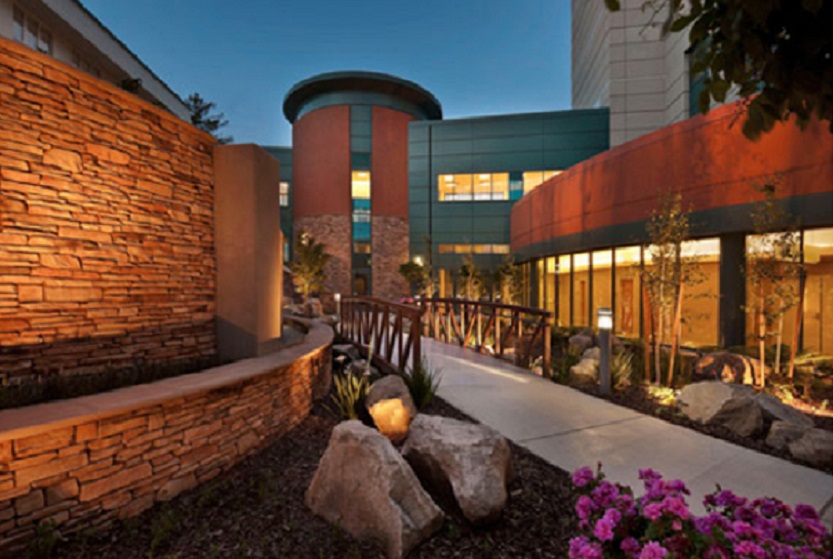
Not long ago, hospitals were almost unanimously thought of as cold institutions filled with hard, unyielding surfaces chosen more for durability and ease of maintenance than for warmth and comfort. The idea that these buildings might be emitting harmful chemicals, which could negatively impact patient and staff wellbeing certainly was not on anyone’s radar screen. In the past few decades, this has changed dramatically as the healthcare field has closely examined what the healing process is all about. This introspection, and the ripple effects it has had on models of care, space planning and product development, has resulted in hospitals becoming, well, more hospitable. They have become more patient-centered, where patients are welcomed like guests, complete with concierge service, on-demand in-room dining, bedside registration and more.
This change in attitude has generated striking innovations in the design of healthcare environments. However, healthcare administrators increasingly have fewer resources to spend and a greatly expanding number of ways to spend it. Therefore, they are justifying expenses by searching for proven strategies that:
- Improve patient safety,
- Improve patient outcomes,
- Increase patient, family and staff satisfaction,
- Improve efficiency and effectiveness of staff, and
- Positively impact the bottom line.
A trend in healthcare design advocates use of evidence-based design (EBD). The latter is defined by the Center for Health Design as “the process of basing decisions about the built environment on credible research to achieve the best possible outcomes.” Currently, more than 1,000 research studies suggest healthcare design can improve patient care and medical outcomes while decreasing medical errors and waste. Healthcare designers are balancing this available research with common sense to design healing environments that can adapt to new ideas as research evolves. But what constitutes a healing environment? Generally, it is considered to be:
- A place to heal the mind, body and soul,
- A place where respect and dignity are woven into everything,
- A place where life, death, illness and healing define the moment, and the building supports those events or situations.
Patient and staff safety, and elimination of stress, remain at the top of any definition of a healing environment. But, a healing environment is more than a safe building. It is one that embraces patients, visitors and staff while supporting them during their stay. Ultimately, the definition of a “healing” environment must be developed by the healthcare facility’s multidisciplinary team. They must first understand the mission, goals and objectives for the project, and understand and translate evidence-based design research into a meaningful and financially sound design and construction plan.
The Military Health System (MHS) provides an ideal example of a healthcare system that is using research to create healing environments. It has identified five evidence-based design principles, which inform the decision-making process when designing healing environments for America’s warriors and their families. Those principles and some corresponding design elements are described below:
1. Create a patient-and family-centered environment.This principle is reflected in the MHS culture of caring, which encourages environments for both patient and family. Design elements include incorporating a large, comfortable family zone in the private patient room, and creating enclosed “team” rooms where staff can talk without being overheard by patients or family members. Patient privacy and confidentiality is improved by grouping furniture in waiting areas with dividers between them, using staggered and screened check-in and check-out areas, and carefully placing patient monitoring screens and private areas for consultations and grieving.
Improving patient rest is extremely important in the healing process. Private rooms with carpeted corridors, minimal paging, and ceiling tiles with high sound-absorption ratings help reduce noise and provide the proper environment. Additionally, decreased exposure to harmful chemicals can be achieved by using a “green” cleaning program and conscientiously selecting finishes with low Volatile Organic Compounds (VOCs) to minimize release of harmful chemicals into the air.
2. Improve the quality and safety of healthcare. Improving safety should be at the top of the goals and objectives in any new construction or renovation. Suggestions from MHS and other sources include: a.) reducing hospital-acquired infections via airborne, contact and water transmissions by locating handwashing sinks in highly visible and separate locations, b.) placing several antimicrobial gel dispensers in patient rooms and exam rooms, and c.) increasing use of HEPA filtration systems in patient rooms, emergency exam rooms and other zones with the most vulnerable patients, such as cancer care. Private rooms also reduce infections and stress for the patient and family members.
Medication errors can be reduced by providing increased lighting in pharmacies, laboratories and other areas where high visibility can help minimize mistakes. Decentralized medication administration provided in patient rooms has been effective in reducing medication errors as well. Locating a decentralized caregiver area just outside the patient room, with a window so the caregiver can see into the room, has also proven successful for many hospitals. Using slip-resistant flooring, especially in patient bathrooms, can also reduce slip/fall rates. Locating the patient bed on the same wall as the bathroom, and providing a handrail from bed to bathroom, is a concept that has not yet been proven to reduce patient falls. However, anecdotal evidence is convincing many to consider this approach.
3. Enhance care of the whole person by providing contact with nature and positive distractions.Connections to nature, such as outdoor views and access to gardens, can decrease patient, staff and family stress. They also provide a temporary distraction from the stress associated with diagnostic and treatment activities. Design elements to be considered include: rooms with views of nature that can elicit positive emotions, and windows in staff areas that help personnel stay oriented to time of day and weather conditions for improved wellbeing. Providing control over light, glare and temperature in work spaces also helps staff adjust the environment to their personal needs. Even providing the option of higher light levels for older eyes is beneficial and helps reduce errors and eyestrain.
4. Create a positive work environment. Healing environments not only contribute to patient wellbeing but also to the wellbeing of physicians, nurses, facilities staff and administrators who work in the building. These positive work environments contribute greatly to improved staff recruitment and retention – two critical factors in a field facing labor shortages. For example, back pain and work-related injuries, as well as staff fatigue, can be reduced by installing patient lifts in all patient rooms, designated exam rooms, and procedure rooms. Noisy and chaotic environments can be eliminated by lowering decibel levels to 35 in patient areas.
5. Design for maximum standardization, future flexibility and growth. Constant advances in medical diagnostics and treatment modalities, along with associated technologies, means hospitals must have the capability to adapt to these changes efficiently and with minimal investment. Designers and planners can accommodate this need by designing in flexibility. For example, a facility designed around a modular concept is typically most flexible.
Case Study: Fort Belvoir Community Hospital
Fort Belvoir Community Hospital is a 1.275-million-square-foot facility that opened in 2011 as part of the Base Realignment and Closures (BRAC) Act. Early in the project, the Joint Task Force responsible for the new hospital challenged the HDR/Dewberry design team to make the hospital “world-class.”
A world-class medical facility is one where the best of the art and science of medicine come together in a focused effort to meet the needs of the patient by providing the best in physical, mental, social and spiritual care.
A palette of warm, neutral colors was developed for the poured terrazzo, sheet rubber for the clinics, low-VOC paint, bio-based tile and solid surface countertops. Many evidence-based design elements incorporated into both inpatient and outpatient hospital areas include:
- Readily accessible and visible healing gardens between each of the clinics and the hospital tower,
- Attention to wayfinding for ease of navigating through the hospital,
- Enhanced indoor air quality through HEPA filtration and ultraviolet technology,
- Enhanced finishes for sound absorption and infection control,
- Modular planning in clinics and patient tower to provide flexibility and improved efficiency (The modular units proved effective in site-adapting for other healthcare facilities.),
- Single patient rooms with implied zones for family and staff,
- Integrated ceiling-mounted patient lifts within each patient room for staff support,
- Cerner Smart Room technology for optimal patient control of environment,
- Distributed staff support and services in closer proximity to patient rooms, and
- Combination intensive care and intermediate care unit to decrease patient transfers.
Becoming a world-class design also meant Fort Belvoir Community Hospital would work toward a LEED Silver certification, to be achieved through a combination of energy conservation and sustainable practices. Distinctive features integrated into the design include:
- The building will consume 27.6 percent less energy (based on regulated energy savings) than a typical hospital, which equates to $449,299 savings per year. This equates to an approximately 4,000 ton reduction in CO2 emissions. Energy savings are being achieved by a multi-stack heat recovery chiller system for reheating, high efficiency variable speed drive chillers, variable air volume devices, an energy efficient lighting design, including daylight harvesting, and rainscreen system;
- The project will save 1.6 million gallons of potable water per year by utilizing a rainwater and condensate collection system. Water is directed from swooped roofs to two underground cisterns that hold a combined total volume of 160,000 gallons, which are reused to irrigate the landscaping on site;
- Native and adaptive plantings contribute to water savings and restore native species to the site;
- The quality, quantity and rate of stormwater run-off do not exceed amounts prior to construction by restoring 60 percent of the site with native and adaptive plantings, and by using a vegetated roof system on much of the hospital, plus pervious pavement, curbless parking spaces, rain gardens and river rock beds, and stream restoration projects in the surrounding areas;
- Construction waste materials were diverted from the local landfill by recycling and minimizing packaging by manufacturers. The project cumulatively recycled more than 5,700 tons, or 90 percent, of its waste.
Many design interventions can help create a healing environment. Deciding which aspects to focus on, and ultimately measure, must be determined on a case-by-case basis. By effectively incorporating the healing process of design, Fort Belvoir Community Hospital has become a world-class hospital and model for the entire Military Health System.
The original article is from Health21’s sister publication, livebetter, and can be found at http://livebettermagazine.com/article/the-healing-process-of-design/.
HDR Architecture has delivered award-winning, integrated healthcare planning and design to some of the world’s foremost medical centers and health systems for more than 50 years. The company embraces forward-thinking leadership and demonstrates the expertise necessary to deliver facilities that are innovative, flexible and efficient, which support a healing, sensitive environment for patients, their families and the healthcare staff. For more information, go to http://www.hdrarchitecture.com.
Image Courtesy HDR

